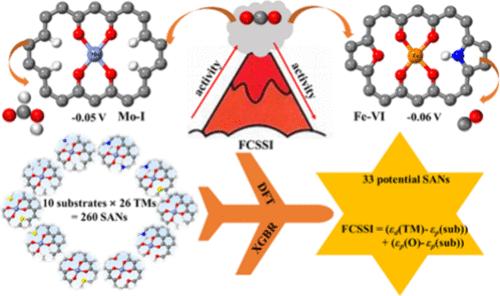利用 O 配位单原子纳米酶推进 CO2RR:DFT 和机器学习探索
IF 13.1
1区 化学
Q1 CHEMISTRY, PHYSICAL
引用次数: 0
摘要
电化学二氧化碳还原反应(CO2RR)为实现零碳排放提供了一条前景广阔的途径。最近出现的单原子纳米酶(SANs)结合了单原子催化剂(SACs)和纳米酶的优点,在 CO2RR 电催化应用中显示出潜力。在此,我们设计了 260 种碳支撑的 TMO4 SANs,在配位层外引入杂原子以调节第一配位层与支撑结构之间的相互作用。利用密度泛函理论(DFT)和机器学习(ML)的协作工作流程,我们对这些 SAN 的 CO2RR 性能进行了评估。其中,185 种 SAN 表现出很高的稳定性。我们的模型基于极端梯度提升回归 (XGBR),并在 100 个标记的 SAN 上进行了训练,成功预测了 85 个 SAN 的极限电位 (UL)。与基准 TMN4-C 催化剂相比,我们从中筛选出 33 种具有更高活性、良好的特定产物选择性和更强的氢进化反应(HER)抑制能力的 SAN。特别是外部掺杂 H 的石墨烯上支持的 MoO4(Mo-I)和外部掺杂 N、O 的石墨烯上支持的 FeO4(Fe-VI)表现出显著的酶模拟特性,Mo-I 表现出类似甲酸脱氢酶的行为,Fe-VI 则模拟 CO 脱氢酶,UL 值分别为 -0.05 和 -0.06 V。通过多重特征工程和电子结构特性分析,我们确定了第一配位层-支撑相互作用(FCSSI)是调节催化剂性能的关键描述因子。我们希望这些见解能为探索用于 CO2RR 的潜在 SAN 提供有价值的指导。本文章由计算机程序翻译,如有差异,请以英文原文为准。

Advancing CO2RR with O-Coordinated Single-Atom Nanozymes: A DFT and Machine Learning Exploration
Electrochemical CO2 reduction reaction (CO2RR) offers a promising route toward zero-carbon emissions. Recently emerged single-atom nanozymes (SANs), which combine the advantages of single-atom catalysts (SACs) and nanozymes, show potential in CO2RR electrocatalysis applications. Herein, we designed 260 carbon-supported TMO4 SANs, introducing heteroatoms outside the coordination sphere to modulate the interaction between the first-coordination sphere and the support structure. Using a collaborative workflow of the density functional theory (DFT) and machine learning (ML), we assessed these SANs for the CO2RR performance. Among them, 185 SANs demonstrated high stability. Our model, based on extreme gradient boosting regression (XGBR) and trained on 100 labeled SANs, successfully predicted the limiting potentials (UL) for 85 SANs. From these, we distinguished 33 SANs with superior activity, good specific product selectivity, and greater hydrogen evolution reaction (HER) suppression compared with benchmark TMN4-C catalysts. Particularly, MoO4 supported on external H-doped graphene (Mo-I) and FeO4 supported on external N,O-doped graphene (Fe-VI) exhibited remarkable enzyme-mimicking characteristics, with Mo-I showing a formate dehydrogenase-like behavior and Fe-VI mimicking CO dehydrogenase with UL values of −0.05 and −0.06 V, respectively. Through ML feature engineering and electronic structure property analysis, we determined the first-coordination sphere–support interaction (FCSSI) as a key descriptor in regulating the catalyst performance. We hope that these insights may provide valuable guidance for exploring potential SANs for CO2RR.
求助全文
通过发布文献求助,成功后即可免费获取论文全文。
去求助
来源期刊

ACS Catalysis
CHEMISTRY, PHYSICAL-
CiteScore
20.80
自引率
6.20%
发文量
1253
审稿时长
1.5 months
期刊介绍:
ACS Catalysis is an esteemed journal that publishes original research in the fields of heterogeneous catalysis, molecular catalysis, and biocatalysis. It offers broad coverage across diverse areas such as life sciences, organometallics and synthesis, photochemistry and electrochemistry, drug discovery and synthesis, materials science, environmental protection, polymer discovery and synthesis, and energy and fuels.
The scope of the journal is to showcase innovative work in various aspects of catalysis. This includes new reactions and novel synthetic approaches utilizing known catalysts, the discovery or modification of new catalysts, elucidation of catalytic mechanisms through cutting-edge investigations, practical enhancements of existing processes, as well as conceptual advances in the field. Contributions to ACS Catalysis can encompass both experimental and theoretical research focused on catalytic molecules, macromolecules, and materials that exhibit catalytic turnover.
 求助内容:
求助内容: 应助结果提醒方式:
应助结果提醒方式:


